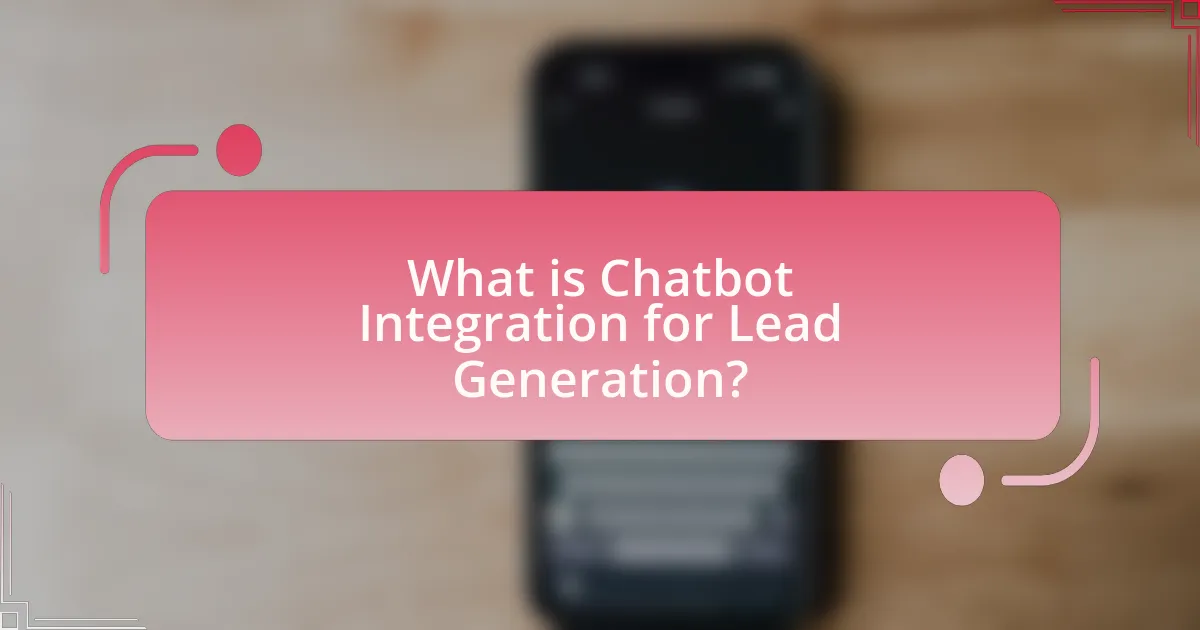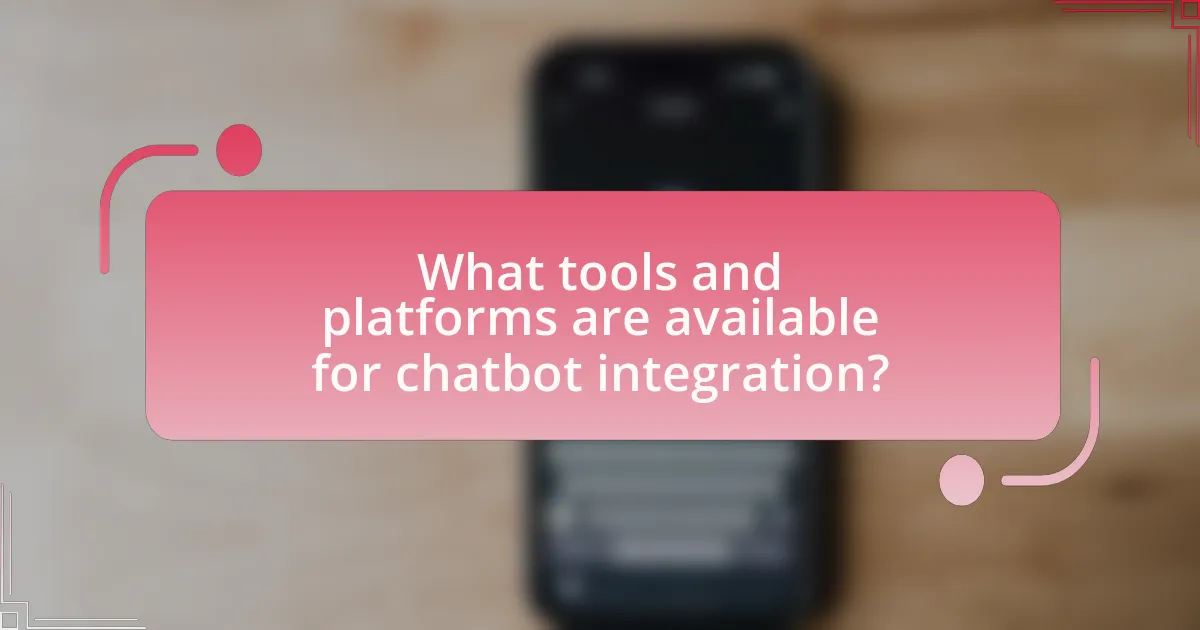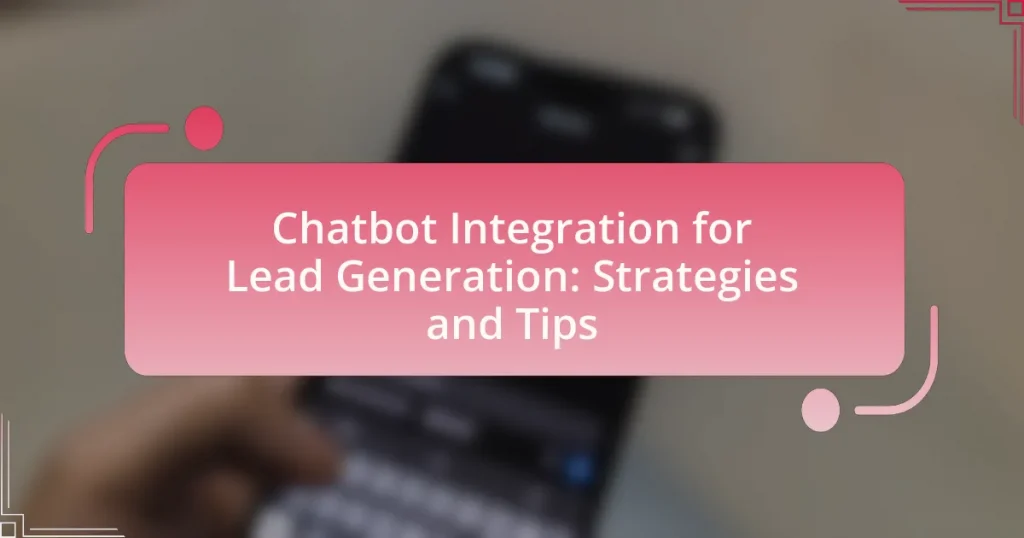Chatbot integration for lead generation involves incorporating chatbot technology into marketing strategies to effectively capture and qualify potential customers. This article explores how chatbots facilitate lead generation through real-time engagement, qualification of leads, and data collection, highlighting their advantages over traditional methods. Key functionalities, best practices for design, and strategies for effective integration are discussed, along with metrics for measuring success and common challenges faced during implementation. The article also examines various tools and platforms available for chatbot integration, emphasizing the importance of continuous learning and user engagement in optimizing chatbot performance for lead generation.

What is Chatbot Integration for Lead Generation?
Chatbot integration for lead generation refers to the process of incorporating chatbot technology into marketing strategies to capture and qualify potential customers. This integration allows businesses to engage with website visitors in real-time, answer inquiries, and collect contact information, thereby streamlining the lead generation process. According to a study by HubSpot, companies using chatbots can increase lead generation by up to 50% due to their ability to provide instant responses and personalized interactions.
How do chatbots facilitate lead generation?
Chatbots facilitate lead generation by engaging potential customers in real-time conversations, thereby capturing their information and interests. These automated systems can qualify leads through targeted questions, ensuring that only the most relevant prospects are passed on to sales teams. According to a study by Drift, 62% of consumers prefer to engage with a chatbot for quick questions, highlighting their effectiveness in initiating contact and gathering data. Additionally, chatbots can operate 24/7, providing immediate responses that enhance user experience and increase the likelihood of conversion.
What are the key functionalities of chatbots in lead generation?
Chatbots in lead generation primarily function to engage potential customers, qualify leads, and facilitate data collection. They initiate conversations with website visitors, providing instant responses to inquiries, which enhances user experience and keeps potential leads engaged. Additionally, chatbots can ask qualifying questions to assess the interest level and readiness of leads, effectively filtering out unqualified prospects. They also gather valuable information such as contact details and preferences, which can be used for targeted marketing efforts. According to a study by HubSpot, businesses using chatbots for lead generation report a 30% increase in lead conversion rates, demonstrating their effectiveness in this role.
How do chatbots interact with potential leads?
Chatbots interact with potential leads by engaging them in real-time conversations, providing instant responses to inquiries, and guiding them through the sales funnel. These automated systems utilize natural language processing to understand user queries and deliver relevant information, which enhances user experience and increases the likelihood of conversion. According to a study by Drift, 64% of consumers believe that the 24/7 availability of chatbots improves their overall experience, demonstrating their effectiveness in lead engagement.
Why is chatbot integration important for businesses?
Chatbot integration is important for businesses because it enhances customer engagement and streamlines operations. By providing instant responses to customer inquiries, chatbots improve user experience, leading to higher satisfaction rates. According to a study by Juniper Research, chatbots are expected to save businesses over $8 billion annually by 2022 through reduced operational costs and increased efficiency. This integration allows businesses to handle multiple customer interactions simultaneously, ensuring that no potential lead is overlooked. Furthermore, chatbots can collect valuable data on customer preferences, enabling targeted marketing strategies that drive lead generation.
What advantages do chatbots provide over traditional lead generation methods?
Chatbots provide several advantages over traditional lead generation methods, primarily through their ability to engage users in real-time and automate responses. Unlike traditional methods that often rely on static forms or delayed responses, chatbots can interact with potential leads instantly, answering questions and guiding them through the sales funnel 24/7. This immediacy can significantly increase conversion rates; for instance, studies show that businesses using chatbots can see a 20-30% increase in lead generation efficiency. Additionally, chatbots can handle multiple inquiries simultaneously, reducing wait times and improving user experience, which traditional methods cannot match. Furthermore, chatbots can collect and analyze data on user interactions, allowing for more personalized follow-ups and targeted marketing strategies, enhancing overall lead quality.
How can chatbots enhance customer engagement?
Chatbots enhance customer engagement by providing instant, personalized interactions that cater to user needs. They can answer queries, offer product recommendations, and facilitate transactions 24/7, which significantly improves customer satisfaction. According to a study by HubSpot, 71% of consumers are willing to use chatbots for quick communication with brands, indicating a strong preference for immediate responses. Additionally, chatbots can analyze customer data to tailor conversations, leading to a more engaging experience. This capability not only fosters loyalty but also increases the likelihood of repeat business, as evidenced by a report from Salesforce, which found that 64% of consumers believe that customer experience is more important than price when making a purchase decision.

What strategies can be employed for effective chatbot integration?
Effective chatbot integration can be achieved through strategies such as defining clear objectives, ensuring seamless user experience, and utilizing data analytics for continuous improvement. Defining clear objectives involves identifying specific goals for the chatbot, such as lead generation or customer support, which guides its design and functionality. Ensuring a seamless user experience requires the chatbot to be easily accessible across platforms and to provide intuitive interactions, enhancing user satisfaction. Utilizing data analytics allows businesses to track performance metrics, understand user behavior, and refine the chatbot’s responses, leading to improved engagement and conversion rates. These strategies are supported by studies showing that businesses with well-defined chatbot objectives see a 30% increase in lead conversion rates, highlighting the importance of strategic integration.
How should businesses define their lead generation goals with chatbots?
Businesses should define their lead generation goals with chatbots by establishing clear metrics such as the number of qualified leads, conversion rates, and engagement levels. These metrics provide a quantifiable framework to assess the effectiveness of chatbots in capturing and nurturing leads. For instance, a study by HubSpot found that companies using chatbots for lead generation experienced a 30% increase in lead conversion rates, demonstrating the potential impact of setting specific goals. By focusing on these measurable outcomes, businesses can optimize their chatbot strategies to enhance lead generation efforts effectively.
What metrics should be considered when setting goals?
When setting goals for chatbot integration in lead generation, key metrics to consider include conversion rate, engagement rate, customer satisfaction score, and response time. The conversion rate measures the percentage of leads that become customers, indicating the effectiveness of the chatbot in driving sales. Engagement rate reflects how actively users interact with the chatbot, which is crucial for assessing user interest and retention. Customer satisfaction score gauges user experience and satisfaction with the chatbot, providing insights into areas for improvement. Lastly, response time is critical as it affects user experience; faster responses typically lead to higher satisfaction and engagement. These metrics collectively provide a comprehensive view of the chatbot’s performance in achieving lead generation goals.
How can businesses align chatbot functions with their lead generation objectives?
Businesses can align chatbot functions with their lead generation objectives by programming chatbots to engage users through personalized interactions and data collection. By utilizing natural language processing, chatbots can ask targeted questions that qualify leads based on specific criteria, such as budget or project timelines. Furthermore, integrating chatbots with customer relationship management (CRM) systems allows for seamless data transfer, enabling businesses to track interactions and follow up with potential leads effectively. Research indicates that companies using chatbots for lead generation can increase conversion rates by up to 30%, demonstrating the effectiveness of this approach in achieving lead generation goals.
What are the best practices for designing a lead generation chatbot?
The best practices for designing a lead generation chatbot include defining clear objectives, ensuring user-friendly interactions, and integrating with existing systems. Clear objectives guide the chatbot’s functionality, such as qualifying leads or scheduling appointments, which increases efficiency. User-friendly interactions involve using natural language processing to understand user queries and providing quick, relevant responses, enhancing user experience. Integration with existing systems, like CRM platforms, allows for seamless data transfer and follow-up, improving lead management. According to a study by Drift, 62% of consumers prefer to engage with chatbots for quick answers, highlighting the importance of effective design in lead generation.
How can conversational design improve user experience?
Conversational design can improve user experience by creating intuitive and engaging interactions that facilitate seamless communication between users and chatbots. Effective conversational design employs natural language processing to understand user intent, allowing for personalized responses that meet user needs. Research indicates that well-designed conversational interfaces can increase user satisfaction by up to 70%, as they reduce friction in obtaining information and completing tasks. This enhancement in user experience leads to higher engagement rates and improved conversion metrics in lead generation efforts.
What types of questions should a lead generation chatbot ask?
A lead generation chatbot should ask questions that identify user needs, qualify leads, and gather contact information. These questions typically include inquiries about the user’s specific interests, budget, timeline for purchase, and preferred method of communication. For example, a chatbot might ask, “What product are you interested in?” or “What is your budget range?” These types of questions help the chatbot to segment leads effectively and tailor follow-up communication. Research indicates that targeted questions can increase engagement rates by up to 30%, demonstrating their effectiveness in lead generation strategies.

What tools and platforms are available for chatbot integration?
Several tools and platforms are available for chatbot integration, including Dialogflow, Microsoft Bot Framework, and Chatfuel. Dialogflow, developed by Google, offers natural language processing capabilities and integrates seamlessly with various messaging platforms. Microsoft Bot Framework provides a comprehensive environment for building and deploying chatbots across multiple channels, including Skype and Teams. Chatfuel is a user-friendly platform that allows users to create chatbots for Facebook Messenger without coding. These platforms are widely used due to their robust features and ease of integration, making them suitable for lead generation strategies.
Which chatbot platforms are most effective for lead generation?
The most effective chatbot platforms for lead generation include HubSpot, Drift, Intercom, and ManyChat. HubSpot offers integrated CRM features that enhance lead tracking and nurturing, while Drift specializes in real-time conversations that convert visitors into leads. Intercom provides personalized messaging and automation, which increases engagement rates, and ManyChat focuses on social media platforms, particularly Facebook Messenger, to capture leads effectively. These platforms have demonstrated success through user adoption rates and case studies showing increased conversion rates, making them reliable choices for businesses aiming to enhance their lead generation efforts.
What features should businesses look for in a chatbot platform?
Businesses should look for scalability, natural language processing capabilities, integration options, analytics and reporting features, and user-friendly design in a chatbot platform. Scalability ensures that the chatbot can handle increasing volumes of interactions as the business grows. Natural language processing capabilities allow the chatbot to understand and respond to user inquiries effectively, enhancing user experience. Integration options with existing systems, such as CRM and marketing tools, facilitate seamless data flow and improve lead management. Analytics and reporting features provide insights into user interactions and chatbot performance, enabling businesses to optimize their strategies. A user-friendly design ensures that both customers and employees can easily navigate and utilize the chatbot, leading to higher engagement and satisfaction.
How do different platforms compare in terms of ease of integration?
Different platforms vary significantly in terms of ease of integration, with some offering more user-friendly APIs and pre-built connectors than others. For instance, platforms like Zapier and Integromat provide extensive libraries of integrations that simplify the process for users without coding experience, while others, such as custom-built solutions, may require more technical expertise and time to implement. According to a survey by Software Advice, 70% of users reported that ease of integration was a critical factor in their platform selection, highlighting the importance of this aspect in the decision-making process.
How can businesses ensure successful chatbot implementation?
Businesses can ensure successful chatbot implementation by clearly defining objectives and selecting the right technology. Establishing specific goals, such as improving customer service or increasing lead generation, guides the design and functionality of the chatbot. Choosing a technology that aligns with these goals, such as natural language processing capabilities, enhances user interaction and satisfaction. According to a study by Gartner, organizations that set clear objectives for their chatbots see a 70% higher success rate in achieving desired outcomes.
What role does testing play in chatbot deployment?
Testing plays a critical role in chatbot deployment by ensuring functionality, accuracy, and user satisfaction. Through rigorous testing, developers can identify and rectify issues such as misinterpretations of user queries, bugs in the conversation flow, and integration problems with other systems. For instance, a study by the Stanford University NLP Group highlights that effective testing can improve chatbot performance by up to 30%, significantly enhancing user engagement and lead generation capabilities. This validation process is essential for delivering a reliable and efficient chatbot that meets user expectations and business objectives.
How can feedback be utilized to improve chatbot performance?
Feedback can be utilized to improve chatbot performance by systematically analyzing user interactions and identifying areas for enhancement. By collecting user feedback through ratings, surveys, or direct comments, developers can pinpoint specific issues such as misunderstanding user queries or providing irrelevant responses. For instance, a study by the Stanford University researchers found that chatbots that adapt based on user feedback can increase user satisfaction by up to 30%. This data-driven approach allows for targeted updates to the chatbot’s algorithms, improving its ability to understand context and deliver accurate information, ultimately leading to better user engagement and higher conversion rates in lead generation.

What common challenges arise with chatbot integration for lead generation?
Common challenges that arise with chatbot integration for lead generation include ensuring accurate natural language understanding, maintaining user engagement, and integrating with existing CRM systems. Accurate natural language understanding is crucial, as chatbots must interpret user queries correctly to provide relevant responses; failure in this area can lead to user frustration and disengagement. Maintaining user engagement is another challenge, as chatbots need to keep conversations flowing and relevant to prevent users from losing interest. Additionally, integrating chatbots with existing CRM systems can be complex, as it requires seamless data transfer and compatibility with various platforms, which can hinder the effectiveness of lead generation efforts.
What are the potential pitfalls of chatbot implementation?
The potential pitfalls of chatbot implementation include inadequate understanding of user needs, leading to poor user experience. When chatbots fail to accurately interpret user queries or provide relevant responses, they can frustrate users and damage brand reputation. Additionally, over-reliance on automation can result in a lack of human touch, which is crucial for building customer relationships. According to a study by Gartner, by 2022, 70% of customer interactions will involve emerging technologies such as chatbots, highlighting the importance of effective implementation. Furthermore, insufficient training data can lead to chatbots that do not perform well in real-world scenarios, as evidenced by various case studies where poorly designed chatbots failed to meet user expectations.
How can businesses address user resistance to chatbots?
Businesses can address user resistance to chatbots by enhancing user experience through transparency, personalization, and effective communication. Transparency involves clearly informing users about the chatbot’s capabilities and limitations, which builds trust. Personalization can be achieved by tailoring interactions based on user data, making the experience more relevant and engaging. Effective communication includes using natural language processing to ensure the chatbot understands user queries accurately and responds appropriately. Research indicates that 70% of users prefer chatbots that can provide personalized responses, highlighting the importance of these strategies in reducing resistance and improving user satisfaction.
What technical issues might arise during integration?
Technical issues that might arise during integration include data compatibility problems, API limitations, and security vulnerabilities. Data compatibility issues occur when different systems use incompatible formats or structures, leading to difficulties in data exchange. API limitations can restrict functionality, as some APIs may not support all required features or may have rate limits that hinder performance. Security vulnerabilities may arise if proper authentication and encryption measures are not implemented, exposing sensitive information during data transfer. These issues can significantly impact the effectiveness of chatbot integration for lead generation.
How can businesses measure the success of their chatbot in lead generation?
Businesses can measure the success of their chatbot in lead generation by tracking key performance indicators (KPIs) such as conversion rates, engagement rates, and the number of qualified leads generated. For instance, a study by Drift found that chatbots can increase conversion rates by up to 30% when effectively integrated into the sales funnel. Additionally, analyzing user interactions can provide insights into engagement levels, with metrics like average response time and user satisfaction scores serving as indicators of chatbot effectiveness. By comparing the number of leads generated before and after chatbot implementation, businesses can quantify the impact of the chatbot on their lead generation efforts.
What key performance indicators should be tracked?
Key performance indicators (KPIs) that should be tracked for chatbot integration in lead generation include conversion rate, engagement rate, response time, and customer satisfaction score. The conversion rate measures the percentage of interactions that lead to a desired action, such as filling out a form or making a purchase, which is crucial for assessing the effectiveness of the chatbot in generating leads. The engagement rate indicates how actively users interact with the chatbot, reflecting its ability to capture interest and maintain user attention. Response time is critical as it affects user experience; faster responses typically lead to higher satisfaction and retention. Finally, the customer satisfaction score, often gathered through post-interaction surveys, provides direct feedback on user experience and the chatbot’s performance in meeting user needs. Tracking these KPIs allows businesses to optimize their chatbot strategies and improve lead generation outcomes.
How can businesses analyze chatbot interactions to improve lead quality?
Businesses can analyze chatbot interactions to improve lead quality by utilizing data analytics tools to track conversation metrics such as engagement rates, response times, and user satisfaction scores. By examining these metrics, businesses can identify patterns in user behavior and preferences, allowing them to refine their chatbot scripts and responses. For instance, a study by Salesforce found that 69% of consumers prefer chatbots for quick communication, indicating that optimizing for speed and clarity can enhance lead quality. Additionally, sentiment analysis can be employed to gauge user emotions during interactions, helping businesses to tailor their approach and address potential concerns proactively. This data-driven approach ensures that chatbot interactions are continuously improved, leading to higher quality leads.
What are the top tips for optimizing chatbot performance in lead generation?
To optimize chatbot performance in lead generation, focus on personalization, timely responses, and clear call-to-action prompts. Personalization enhances user engagement; studies show that personalized interactions can increase conversion rates by up to 10%. Timely responses are crucial, as 82% of consumers expect an immediate response from chatbots. Clear call-to-action prompts guide users effectively, leading to higher lead capture rates. Implementing these strategies can significantly improve the effectiveness of chatbots in generating leads.
How can continuous learning enhance chatbot effectiveness?
Continuous learning enhances chatbot effectiveness by enabling the system to adapt and improve its responses based on user interactions. This adaptability allows chatbots to better understand user intent, leading to more accurate and relevant answers. For instance, a study by Google demonstrated that machine learning algorithms can improve response accuracy by up to 30% when continuously trained on new data. By incorporating user feedback and analyzing conversation patterns, chatbots can refine their language models, ultimately increasing user satisfaction and engagement in lead generation processes.
What strategies can be employed to keep leads engaged through chatbots?
To keep leads engaged through chatbots, businesses can implement personalized interactions, timely follow-ups, and interactive content. Personalized interactions, such as addressing users by name and tailoring responses based on previous interactions, enhance user experience and foster a connection. Timely follow-ups ensure that leads receive relevant information or reminders shortly after their initial inquiry, which can increase the likelihood of conversion. Interactive content, such as quizzes or surveys, encourages user participation and keeps the conversation dynamic, making leads more likely to stay engaged. According to a study by HubSpot, personalized messages can increase engagement rates by up to 50%, demonstrating the effectiveness of these strategies in maintaining lead interest.










